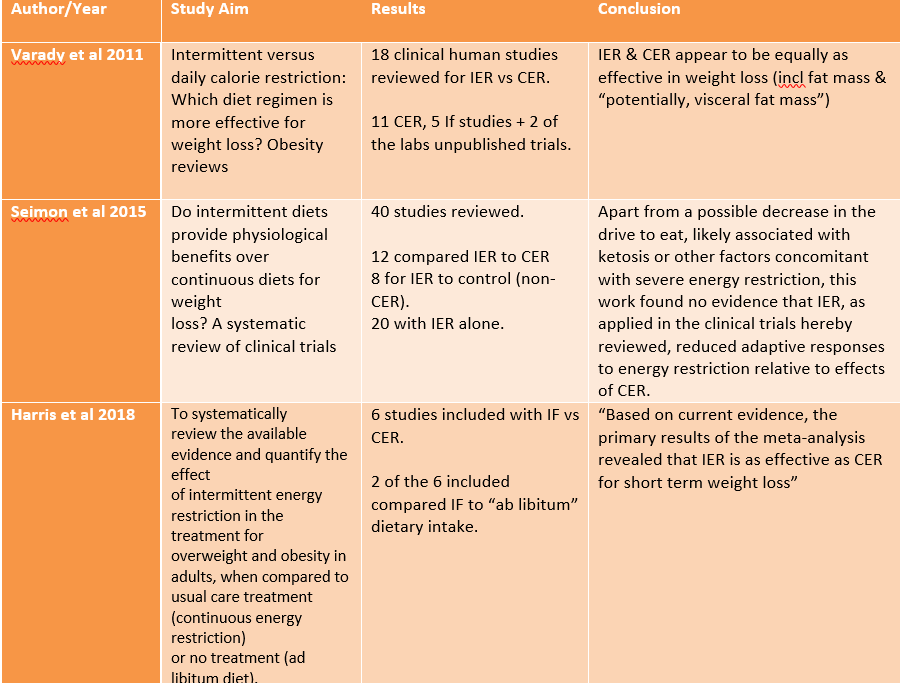Intermittent fasting (IF) explained
Intermittent fasting (IF), otherwise known as time restricted eating/feeding, intermittent energy/calorie restriction.
There are 3 different subclasses for intermittent fasting or intermittent energy/calorie restriction.
- Alternate day fasting (ADF): 24-hour fasting alternated with 24-hour feeding.
- Whole day fasting (WDF): 2 days within the week of fasting.
- Time restricted feeding (TRF): Reduced feeding window daily.
Side note: “Fast” days may be “very low calorie intake” (≤800kcals as defined by Harris et al 2018) opposed to no food intake.
TRF is a popular method of IF used by people. Typically, fasting for 16-20 hours with a feeding window of 4-8 hours.
We will look at three reviews that compared these methods of IF versus continue energy restriction (CER) which is often referred to as “conventional dieting”.

Collectively there are 55 studies reviewed in the table above (as some are in two or all reviews), all concluded that the two (IF vs CER) diet types resulted in “equivalent outcomes”.
Does intermittent fasting work?
Yes, it will work, if it allows you to achieve, sustain & adhere to a calorie deficit.
The same results can be achieved by simply controlling calorie intake, which can be facilitated by any dieting method (i.e. reduced portion size, meal frequency, food choices, etc, etc).
What advantages has it over other methods of dieting in terms of weight loss?
None. No inherent benefits over any other method of dieting. IF doesn’t cause greater weight-loss or higher fat-loss when you equate calories from a non-time restricted (CER) approach to weight-loss.
Personally, it’s not for me on a continual basis. To put it simply, it doesn’t need to exist as a standalone method. People seem to think you must pick a side IF or CER. Sometimes, if I have an event (socialising, dining out, etc) and I’d like some additional kcals for it. I may skip “break-fast” that morning (prolonged fast compared to typical day) and enjoy those kcals later at the event.
There are many tactics/strategies that you can use to help keep you on track and this is just one tool. Therefore, treat it as such, a tool, to allow for enhanced flexibility opposed to structured rigidity.
References:
- Harris, Leanne & Hamilton, Sharon & Azevedo, Liane & Olajide, Joan & De Brún, Caroline & Waller, Gillian & Whittaker, Vicki & Sharp, Tracey & Lean, Mike & Hankey, Catherine & Ells, Louisa. (2018). Intermittent fasting interventions for treatment of overweight and obesity in adults: a systematic review and meta-analysis.
- Seimon, R.V, Roekenes, J.A, Zibellini, J., Zhu, B., Gibson, A.A, Hills, A.P, Wood, R.E, King, N.A, Byrne, N.M, Sainsbury, A., (2015) Do intermittent diets provide physiological benefits over continuous diets for weight loss? A systematic review of clinical trials, Molecular and Cellular Endocrinology.
- Varady, K.A.. (2011). Intermittent versus daily calorie restriction: Which diet regimen is more effective for weight loss?. Obesity reviews : an official journal of the International Association for the Study of Obesity.
